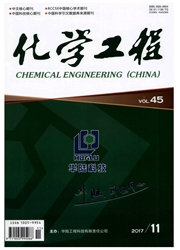

 中文摘要:
中文摘要:
采用热力学非均相反应体系中的Gibbs自由能最小原理,从理论上分析一氧化碳变换催化剂在高炉煤气气氛下,PH3对铜基催化刹的毒害过程可能发生的化学反应及产物,并对各个反应的吉布斯自由能及化学反应平衡常数进行了对比分析,从而进一步了解CO变换催化剂在高炉煤气气氛下的中毒机理,经过分析町得出:PH、对铜基低温变换催化剂往100-300℃的活性温度下,町使催化剂造成暂时或永久性的失活,卞要的中毒产物为CuP2,CuO,Cu2O,Cu3(PO4)2,C,且高炉煤气自身的主要气体混合也可造成催化剂中毒。其中氧气的存仵极易造成铜基催化剂的中毒,其中低温变换催化剂的活性物质Cu微晶与O2反应生成Cu2P2O7的占布斯自由能小于零且绝对值最大,热力学平衡常数最大,该反应是竞争能力最强的主导反应。
 英文摘要:
英文摘要:
By using Gibbs free energy principle of thermodynamics heterogeneous reaction system, the possible chemical reactions and products from the Cu-based catalyst process poisoned with PH3 were analyzed in blast gas atmosphere of CO shift catalyst. Gibbs free energy and equilibrium of reactions were compared to further understand the mechanism of the poisoning mechanism. It concludes that PH3 can poison Cu-based shift catalyst in temporary or permanent and blast furnace gas can also poison catalyst at 100-300 ~C , and the main poisoning products are CUP2, CuO, Cu20, Cu3 (PO4)2, C. Oxygen can cause Cu-based catalyst poisoning extremely easily, of which the Gibbs free energy of Cu2P207 produced by the active substance -Cu microcrystalline of low-temperature shift eatalyst and 02 is less than zero and the absolute value is maximum. This reaction is the most competitive reaction.
 同期刊论文项目
同期刊论文项目
 同项目期刊论文
同项目期刊论文
 期刊信息
期刊信息
